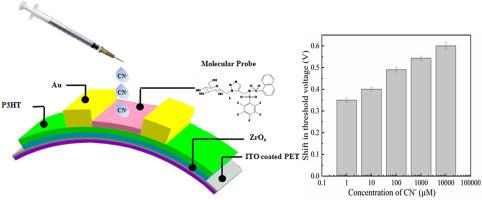Organic Electronics ( IF 2.7 ) Pub Date : 2021-09-08 , DOI: 10.1016/j.orgel.2021.106341 Sudipta Kumar Sarkar 1 , Ajay Kumar Botcha 1 , Dipti Gupta 1

|
Organic thin film transistor (OTFT) based cyanide (CN−) sensor can be of an intense interest due to its simple operation, high sensitivity, system on chip (SoC) integration capacity and applicability towards environmental safety. So, mechanical flexibility of such sensors can extend them to conformable, bio-compatible and wearable applications. In our recent work, a novel OTFT based highly sensitive and mechanically flexible platform was developed to detect CN− in aqueous medium. The sensor was fabricated on a flexible polyethylene terephthalate (PET) substrate by simple spin coating and operated at a very low voltage of −3 V. For the sensing element, a chemically active dansyl-dervatized-triazole linked glucopyranosyl conjugate (DTGC) was used as a molecular probe on the semiconducting poly (3-hexylthiophene) P3HT layer in the device structure. The fabricated sensor was characterized electrically while using an aqueous solution of tetrabutylammonium cyanide (TBAC) as an analyte. Significant changes in device characteristics including 0.4 V shift in threshold voltage, 0.2 cm2v−1s−1 increment in mobility and 2 μA increase in drain current were observed for the OTFT based sensor with presence of CN− analyte. The concentration of the CN− was then varied and thus the minimum detection limit was found to be 1 μM. The sensor also exhibited excellent mechanical flexibility with its stable operation even up to a bending with 5 mm of bending radius. The sensing mechanism of the developed sensor has been explained through the possible charge transfer phenomena from the host semiconductor due to a chemical reaction between the probe layer and the analyte. The sensititvity and chemical reactivity of the molecular probe to the CN− were further confirmed from the microscopic studies and the change in the visual appearance (colour) of the probe with the presence of aqueous CN−.
中文翻译:

用于下一代氰化物传感器的柔性平台上的分子探针层改性有机薄膜晶体管
基于有机薄膜晶体管 (OTFT) 的氰化物 (CN - ) 传感器因其操作简单、灵敏度高、片上系统 (SoC) 集成能力和对环境安全的适用性而备受关注。因此,此类传感器的机械灵活性可以将它们扩展到适应性、生物相容性和可穿戴应用。在我们最近的工作中,开发了一种基于 OTFT 的新型高灵敏度和机械灵活平台来检测 CN -在水介质中。该传感器通过简单的旋涂在柔性聚对苯二甲酸乙二醇酯 (PET) 基板上制造,并在 -3 V 的极低电压下运行。 对于传感元件,使用化学活性丹磺酰衍生三唑连接的吡喃葡萄糖基缀合物 (DTGC)作为器件结构中半导体聚(3-己基噻吩)P3HT 层上的分子探针。在使用四丁基氰化铵 (TBAC) 的水溶液作为分析物时,对制造的传感器进行电学表征。对于存在 CN - 的基于 OTFT 的传感器,观察到器件特性的显着变化,包括阈值电压偏移 0.4 V 、迁移率增加0.2 cm 2 v -1 s -1和漏极电流增加 2 μA 。分析物。然后改变CN -的浓度,因此发现最低检测限为 1 μM。该传感器还表现出出色的机械灵活性,即使在弯曲半径为 5 mm 的情况下也能稳定运行。由于探针层和分析物之间的化学反应,已经通过主体半导体可能的电荷转移现象来解释所开发传感器的传感机制。分子探针对 CN -的敏感性和化学反应性通过显微镜研究和探针在 CN -水溶液的存在下的视觉外观(颜色)的变化得到进一步证实。











































 京公网安备 11010802027423号
京公网安备 11010802027423号